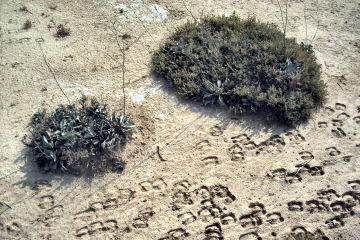Beating the Bush for Patterns
Landscapes lacking a fractal vegetation pattern may be vulnerable to desertification.
- More than 2 years ago
In Africa’s Kalahari Desert as well as some areas around the Mediterranean, trees and bushes grow in clumps scattered in seemingly random locations across an otherwise barren landscape. Two new studies have discovered a fractal pattern in this seeming randomness, and they offer a novel explanation of how it comes about. One study suggests that areas without such a pattern are on the edge of collapse, and that further pressure could tip them into becoming barren deserts.


An American research team studied high resolution satellite photographs of the Kalahari Desert, and a Dutch team did the same for regions around the Mediterranean. Both groups found a simple statistical relationship between the number of vegetation clumps in a given area and that size of those clumps. Known as a “power law,” their finding means, in simple terms, that the smallest clumps are the most common. Clumps get rarer as they get larger, but even very large clumps pop up occasionally.
“I was very surprised to find this,” says Sonia Kéfi of Utrecht University in the Netherlands, lead author of the Mediterranean team. “These kinds of behaviors cannot happen by chance.”
Power laws pop up throughout nature. Recent studies have found them governing the size and frequency of naturally occurring forest fires, avalanches, and mussel beds. Phenomena that obey power laws are fractal, meaning that they present similar patterns on all scales, from the smallest to the largest. So, for example, when looking at a satellite image of the Kalahari, it would be hard to know at a glance whether the photo covers hundreds of miles or only a few acres.
Scientists are still trying to understand why fractals and power laws are so common in nature. They usually arise out of local interactions among the elements of a natural system, rather than in response to some external influence. So in this case, the teams looked at the interactions among the plants, rather than differences in the soil types, for example, as possible causes of the clumping patterns. Indeed, in the Kalahari, the soil is very similar from one area to another, casting further doubt on that line of interpretation.
Both research teams noted that plants have an easier time taking root in the area immediately around existing plants than in areas where nothing is growing. A plant creates a bit of shade and shelter, generates richer soil through the breakdown of fallen leaves, and aerates the earth with its roots. On the other hand, water tends to be scarce in the areas studied, limiting the quantity of plants an area can support. By creating a mathematical model of this scenario, each team showed that the dynamics of cooperation and competition among plants suffice to explain the observed power law relationship. Both groups published their research in the Sept. 13 Nature.
There were some exceptions around the Mediterranean, however. Land heavily grazed by cattle didn’t show the power law relationship. “It’s quite intuitive why,” Kéfi says. “When you have higher grazing pressure, the big patches just aren’t there anymore.” Browsing cattle have broken them up, leaving only fragmented small patches behind.
Kéfi and her colleagues turned to their model to understand the significance of such phenomena. When they mimicked increased grazing pressure in their model by making the plants die more frequently, the increased mortality destroyed the power law. They also noted that any further increase in plant mortality, however slight, would cause the system to collapse. All of its plants would die, and the landscape would become barren desert.
Kéfi says this phenomenon is particularly worrisome because climate change is likely to increase temperatures and decrease precipitation in the Mediterranean, which would increase the pressure on plants in these landscapes. “In the areas we looked at, grazing pressures haven’t changed in a long time,” she says. “The landscapes have probably been like that for decades. But in the next decades with climate change, these systems might collapse.”
The good news is that it may be possible to cut back on grazing to make the landscapes more robust. Because it’s fairly easy to analyze satellite images, Kéfi’s model could allow land managers to identify the most vulnerable areas.
So far, Kéfi and her team have seen landscapes collapse in their model, not in actual areas. They are now analyzing past imagery from landscapes that have turned to barren desert to see if the power law broke down before the collapse.
Despite its name, the Kalahari Desert has substantial vegetation and is not a true desert, and its fractal patterns are apparently in the clear. Todd M. Scanlon of the University of Virginia in Charlottesville and his colleagues saw the power law relationship in every area they examined. “I don’t think there’s any danger of desertification in the Kalahari,” says Scanlon, “at least if you believe our model.”
If you would like to comment on this article, please see the blog version.






